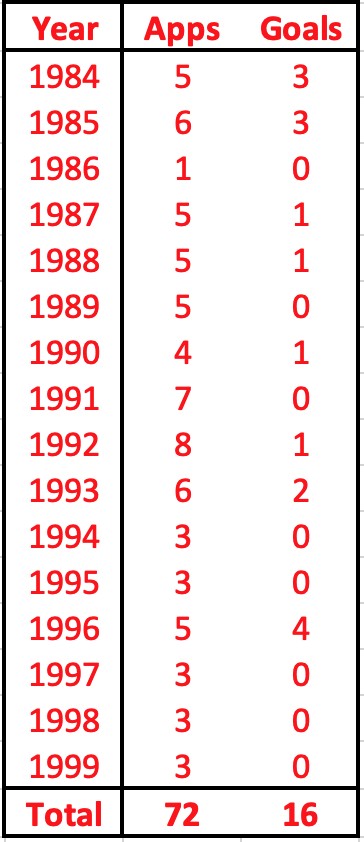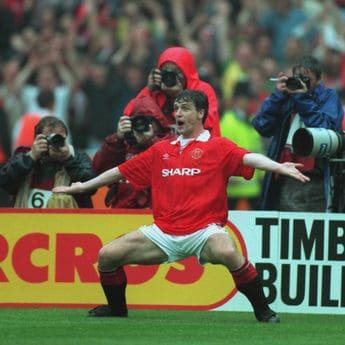Few can boast as illustrious a football career both on and off the pitch as Welshman Mark Hughes, arguably one of the most colorful players and managers to ever grace the game. The legendary Manchester United striker has played for seven different prestigious European clubs and has managed six clubs, as well as his country, in a career spanning 38 years. He has a string of awards and trophies to his name, including being inducted into the English Football Hall of Fame and receiving the OBE.
No one can deny the status of Mark Hughes as one of the Great Red Devils. He combined grace, power, and aggression to become instrumental in the resurgence of Manchester United back to its glory days, and for this, he will forever be a United legend.
While Hughsie scored many wonder goals, for me, the goal that stands out, is the Equalizer against Oldham in the dying minutes at Wembley in 1994. What a goal. United went on to win the double that year – almost a domestic treble, but, when United’s form was waning that season, Hughsie’s late strike against Oldham got United believing again. Let me know in the comments section below, what is your favorite Mark Hughes moment.
Mark Hughes – Early Life
He was born Leslie Mark Hughes on November 1, 1963, in the small village of Ruabon, near Wrexham in Clwyd, Wales. Asked why he didn’t go by his first name “Leslie”, Mark replied that “Mark is my name and Leslie was my father’s name. I was always going to be Mark Leslie Hughes, but maybe it sounded better on the birth certificate as Leslie Mark Hughes. That’s the only reason, but I was always going to be Mark”
Mark attended school at Ysgol Rhiwabon (or “Ruabon School”), a historic educational institution in Ruabon. During his time there, Mark excelled both in sport and in academics. Having been influenced by his father, who played as a goalkeeper, football became his game of choice. This is despite the fact that rugby is the national sport of Wales. Mark explained later in interviews that he didn’t go to a rugby playing school and that the sport wasn’t played as much in his part of North Wales.
He was known by his nickname “Sparky”, a moniker that he would continue to use throughout his playing career. It was a name he picked from a comic book of the same name when he was around 8 years old. Mark explained the origin of that name, saying: “for some reason, me and my friends decided we were going to be nicknamed after a comic. I had a mate called Beano, so I had to pick one. There was a comic called Sparky, it rhymed with Mark, so I picked that. It wasn’t because I was a frustrated electrician or anything, although I did have visions of being one!”
The former headteacher at his school, John Hotchkiss, remembers the young Mark Hughes: “Mark gained a good GCE certificate and had the potential to progress to our sixth form and then go to university.” But fate had other plans.
When Hughes was just 12, a Manchester United talent scout named Hugh Roberts spotted the curly-haired teen playing for his school’s under-16 team and was impressed by the young Mark’s great promise. So much so that, roughly 3 years later in 1978, Roberts offered to sign him for United’s youth team straight out of school. He was only 15 at the time.
Shy and quiet by nature, Mark initially refused to sign with then United manager Dave Sexton. When Roberts asked why he said that he wanted to sign for Roberts and not the manager! His apparently timid personality seemed to belie his nickname. But when drinking with mates, his personality would change as he downed a pint or two, something his Ruabon friends would regularly attest to.
Mark Hughes – Manchester United Years
Mark Hughes officially joined the Manchester United youth setup in the summer of 1980, but would not make his debut for the first team until the 1983/84 seasons. Many of his early days at United were spent training, playing and drinking. He would frequent pubs for most of the week, only laying off the alcohol the night before a match.
After moving into a flat nearer The Cliff – Manchester United’s training ground – it became even easier to drink. Fortunately, he was physically fit and was still able to perform well on the field. Despite this, he remained in the reserves, playing in the midfield for much of the early ’80s.
When Ron Atkinson replaced manager Dave Sexton in 1981, he was tasked with bringing back some of the spark United had been missing. The team’s attacking force at the time included the partnership of star forwards Frank Stapleton and Norman Whiteside.
Mark Hughes back then was, at least to Atkinson’s eyes, just another player in the reserves who made little impression on him. Then assistant manager Syd Owen decided to change things up – by making Mark into a striker. He played up front in a youth match against Sunderland, and that’s when Atkinson became a believer in the young Mark’s potential and began to plan to introduce him into the first team.
Mark Hughes’ breakthrough came in his debut match against Oxford United on November 30, 1983. The game would end in a draw, but it was not the match itself that brought the young Welshman into the spotlight but his debut goal. “He played on the left-wing and scored” recalled a beaming Atkinson.
Ron Atkinson made a few key changes in the team line-up to accommodate Mark Hughes’ new position as striker. That included breaking up the old partnership between Stapleton and Whiteside, partnering the former with Mark and switching the latter to the midfield, to play alongside Ray Wilkins and deputise for Remi Moses.
Breaking up the partnership was difficult and probably uncomfortable for the young Hughes, but he took on the mantle brilliantly. In his debut 1983/84 season as a striker for the first team, he scored four league goals, helping the team to finish fourth in the league.
If some thought the promising 1983/84 season was a fluke for the young striker, then the 1984/85 season would put all the doubts to rest. This was the year Mark cemented his place as a key striker in the United front-line. He ended the season as the top scorer, netting 24 goals for his club and winning the PFA Young Player of the Year award. The season also saw United perform consistently, finishing again in 4th place in the table.
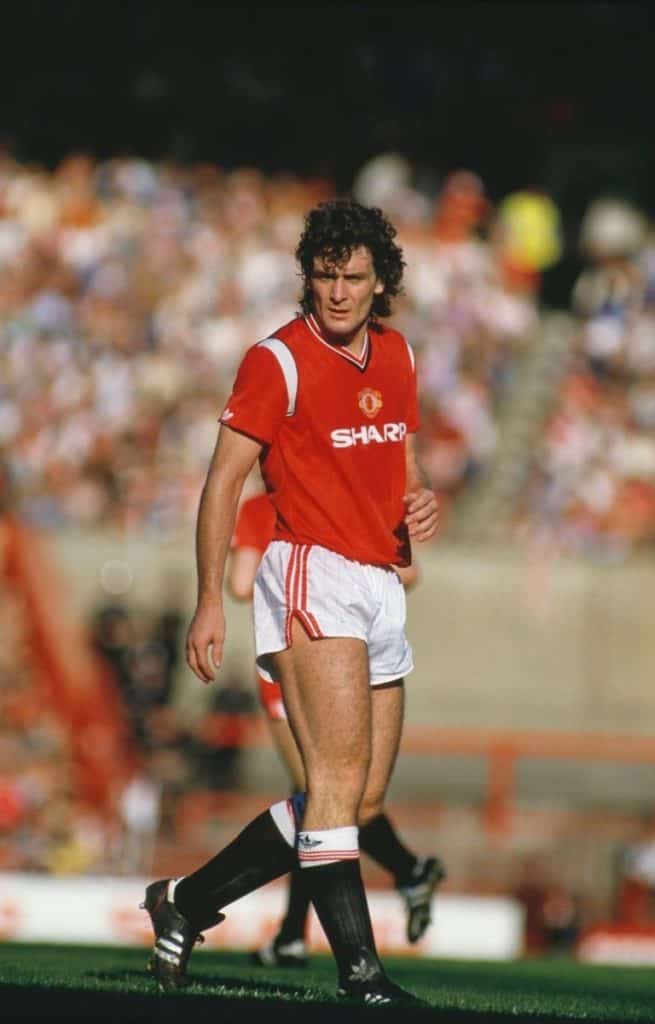
Hughes also gained some big match experience in this season, helping the team on an impressive run to the 1985 FA Cup Final. In an otherwise dull match against Everton, the young Welshman yet again played a key role – this time finding a fantastic pass to Whiteside to allow the Irishman to score a goal in extra time and win the FA Cup with a 1-0 scoreline.
Despite his exploits in the first team, he still remained bracketed with the United reserves. Mark recalls, “I was still in the reserve team dressing room when I was playing in the Cup final, so I never had that relationship with senior players. I played in the team and went back to the reserves. It’s different now. We’ve changed it here, but young players are given it very, very soon – access to the first team dressing rooms, the advantages of being a first-team player.”
The 1985/86 season opened with a bang, with United winning all of their first ten games and topping the league with a 10-point advantage. Unfortunately, they were unable to sustain this level, and the championship would ultimately go to Liverpool. Mark credited this second-half disaster to injuries plaguing key players such as Whiteside, Robson, and Strachan. But some fans believe the dismal outcome was Mark’s fault, thanks to his lackluster performances. To his credit, though, he still finished the season with 18 goals – not too shabby. In truth, it was the rumor that Mark was transferring to Spanish club FC Barcelona that fueled this fan sentiment.
Mark Hughes – The Road to Spain
The rumor was not baseless – Mark had been on Barcelona’s radar ever since an amazing goal he scored against Spain in a qualifying match for the 1986 World Cup. It was the goal that would bring Mark into the international spotlight. (Check out the video to see the amazing strike).
In that particular April 1985 qualifying match, Mark was representing his national team, Wales, near his home town, in Wrexham. They were up against a formidable Spanish team, who had already thrashed the Welsh 3-0 in their previous encounter in Seville.
But as fate would have it, Spain was missing some of their key players that day. Nevertheless, the Spaniards were a credible threat. “They weren’t at the level that they have been in recent times, but they were still a very good team of players from the top clubs like Barcelona and Real Madrid,” says Mark.
But Wales were empowered by a capacity crowd of their own supporters cheering them on. This turned them into a force that even the Spanish defence couldn’t stop. Ian Rush began the assault with a goal just a minute before half-time, tapping the ball past Spanish goalkeeper Luis Arconada.
The glorious moment for Mark Hughes came in the 53rd minute. Peter Nicholas took a free-kick, curling the ball straight to the far post into the Spanish defensive line. The ball was headed down by a defender. With the ball in the air, Hughes waited patiently for the strike, then veered away and launched himself into an incredible mid-air scissor kick, sending the ball with tremendous power and velocity into the top-right corner of the Spanish net.
The crowd went wild. Welsh commentator Idwal Robling shouted into the microphone: “Brrrrrilliaantt!!” What a goal! What a marvelous goal!” It was one of the best goals of Mark Hughes’ career, and all eyes were now on the 21-year old striker. A pass by Mark to Ian Rush in the 86th minute resulted in another goal to win the game for Wales in spectacular fashion, 3-0.
It was a momentous achievement for the Welsh national team. To put the feat it into perspective, it would be 28 years before the Spaniards would lose by such a wide margin again.
Although Wales would eventually fail to qualify for the 1986 World Cup, they had proved to the world that the Welsh national team could compete with the best. More importantly for Mark Hughes, it catapulted his name into the global spotlight.
Aside from his scoring prowess, Mark evolved into a highly competitive footballer. His amazing strength and ability to keep possession also allowed him to create scoring opportunities for others, even under pressure. This style of play earned him the nickname “El Toro” among Spanish fans. He truly was a star player in his era, a status that years later would compare to that of the equally prolific United star, Wayne Rooney.
Impressed by the young Mark’s athleticism and potential, Barcelona manager Terry Venables – an Englishman – offered United almost £2 million to transfer him to the Spanish club. It was an outrageous sum for a player at the time.
At the time, Mark didn’t want to leave United, but two reasons led him to consider taking the Barcelona deal. One, since English clubs were prohibited from joining European competitions following the 1985 Heysel Disaster, playing for the Spanish club would give him much more exposure to the big continental clubs. And two, he felt that United manager Ron Atkinson tended to favour older players at his expense.
In the end, Hughes agreed. In December 1985, he secretly flew to Switzerland and signed for FC Barcelona, although he would not be joining his new club until the end of the 1985/86 season.
Mark Hughes International Years – FC Barcelona and Bayern Munich
After months of keeping it under wraps, United finally confirmed on March 21, 1986, that the rumors were true. Mark Hughes would be transferring to his new club FC Barcelona at the end of the 1986 season.
Together with Hughes, Terry Venables also signed another English League player – Gary Lineker of Everton. The Barcelona chief hoped that this new partnership would be the start of great things at Camp Nou.
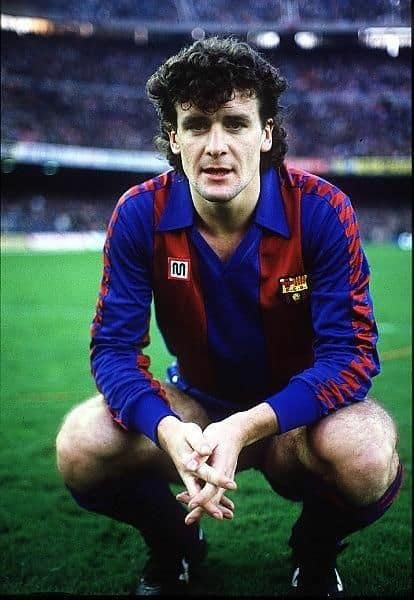
His new club was, unfortunately, not to Mark’s liking. He struggled to find his best form and did not like his new life in Catalonia. His physical style of play did not resonate well with the local fans or Spanish referees who frequently penalised him. The supporters took more of a liking to his more prolific strike partner. What the fans perhaps did not realise was that many of Lineker’s goalscoring opportunities arose from the Welshman’s groundwork.
It would be a disappointing season for him at Barcelona, and ultimately his last in Spain, where he only played 28 times. In a much-needed change of pace, he was loaned to the German side Bayern Munich for the following season. Here, he found his form again backed by much more receptive German fans. A particular highlight came in a single day that saw him play two matches – first for Wales against the Czech team in a Euro 1988 qualifier, and second as a substitute for his club against Borussia Monchengladbach across the border. In the latter match, he came on for the second half, but admitted that he was “hopelessly knackered”!
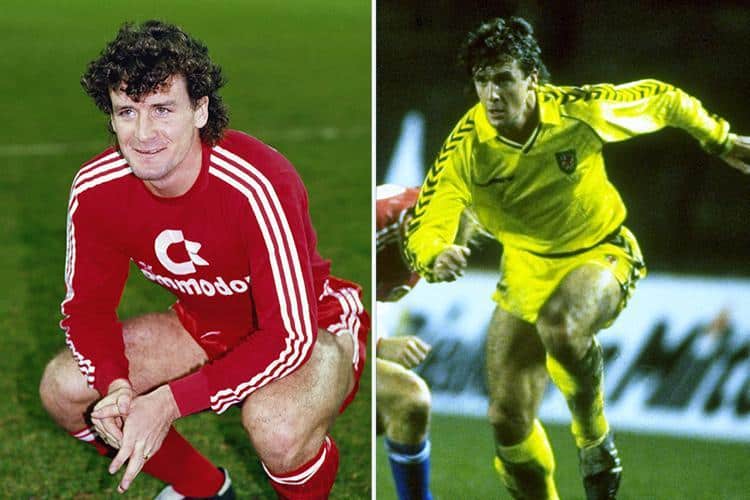
In 1988, Mark Hughes was considering a possible transfer to the Italian team Juventus, following fellow countryman Ian Rush. But the deal did not materialize, and with the unwelcoming treatment he received from the Azzurri in a friendly game with Wales, it was clear that this wasn’t the path for him.
So after two years of experience playing on the Continent and learning much from it, he was pleased to get the opportunity to don the familiar red shirt and play at Old Trafford once again.
Mark Hughes Return to Manchester United
Mark Hughes returned to his former club Manchester United in May of 1988, for a transfer fee of £1.8 million. The team at the time was managed by Sir Alex Ferguson, who would go on to become one of the most successful managers not just of United, but in all of football.
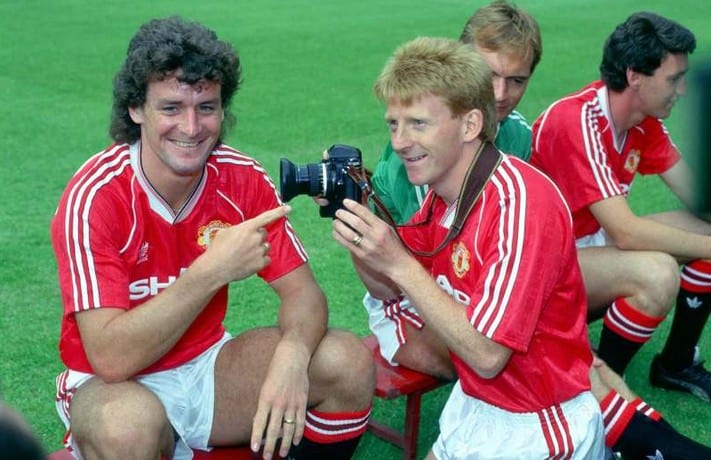
Speaking of his initial reluctance to leave the German side and go back to England, Mark recalls: “It’s in the back of your mind that you should never go back, but it was a different club. Alex Ferguson had replaced Ron Atkinson, there had been a tidying up of discipline and everybody knew which way the club wanted to go. If it had been any other club, I probably would have stayed in Munich but United swayed me.”
Mark saw that Ferguson was very much like him – they were both determined to win for they hated to lose. He was also keen on giving up binge drinking and focused on serious training to get back into form. That would prove fruitful, as Hughes continued his goalscoring prowess for the next seven years at Old Trafford.
Alex Ferguson proved to be effective, if at first unpopular, manager for the team. He did not shy away from making tough decisions for the team’s benefit, even to the ire of the fans, such as getting rid of United legends Norman Whiteside and Gordon Strachan. He would shout at players as close to their face as possible, leading Mark to famously coined the term “hairdryer treatment”.
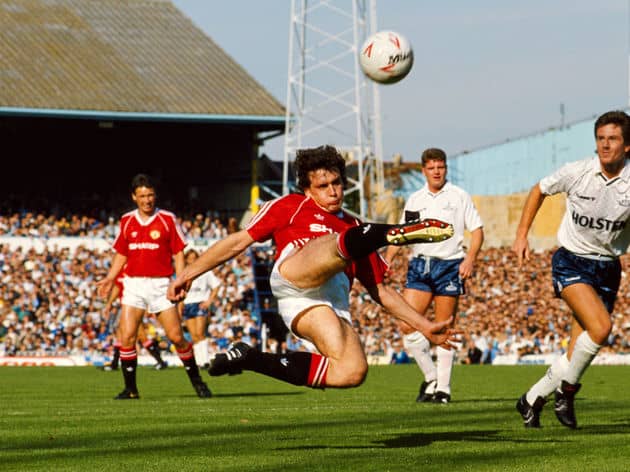
His first season back, in 1988/89, was a slow transitional period as United finished disappointingly in 11th place in the league, after a strong mid-year run. A bad year for the team but not necessarily for Mark, as he was United’s top scorer with 16 goals (jointly with Brian McClair) and was voted PFA Player of the Year, the first United player to ever receive the distinction.
The 1989/90 season did not bring any new developments, at least initially. United would finish 13th in the league, their lowest since being relegated to the Second Division 15 years ago. Mark remembers those tricky early years: “It was difficult the first couple of years; I did OK personally, I won the Player of the Year, but the team itself wasn’t as strong as it was going to be. Then we won the FA Cup, and from then on it was fantastic.”
That FA Cup final was the perfect setting to halt United’s string of bad seasons. The final was against Crystal Palace, and a thrilling contest was drawn 3-3, thanks to 2 goals by Hughes. A replay saw United edge the win 1- 0 thanks to a wonderful Lee Martin goal. It would be United’s first major trophy in 5 years.
It was a much-needed boost that would carry them to an improved following season, where they finished 6th in the league and reached the Football League Cup final (losing unexpectedly to a Sheffield Wednesday side managed by former United boss Ron Atkinson).
But the more important milestone their FA cup momentum carried them to was the European Cup Winners’ Cup final against Mark’s old club, Barcelona. Manchester United would go on to defeat the Spanish team and win the cup, 2-1, courtesy of 2 goals by Mark Hughes himself. Asked if he was tempted to give “payback” to the Barcelona fans (with whom he was unpopular during his time there), he replied that it was his fault that he didn’t play particularly well in Barcelona, and not the fans’.
This European win is also significant because it was the first season that English teams were allowed back in European competitions following the Heysel disaster.
The 1992/93 season saw him join forces with French striker Eric Cantona, while former partner Brian McClair was moved to center midfield. This quickly became an effective and powerful combination that paved the way for what would be a successful United campaign. Mark Hughes was later quoted as saying that the Frenchman “changed my footballing life.”
Off the pitch, Hughes and Cantona weren’t close, although their wives knew each other and were good friends. On the field, Mark would constantly keep an eye on Eric, wary of his tendency for bouts of temper. He’d describe it as “his eyes going a little blacker than usual.” During those times, Mark would tell him: “Leave it to me, Eric, I’ll boot him for you. Calm down and we’ll be alright.”
He and Eric Cantona continued to be prolific goal scorers, successfully netting a total of 25 times in all competitions in the 1992/93 season. This season was particularly noteworthy, as it ended with United winning their first-ever Premier League title, a wait of 26 years was over, and Hughes was United’s top scorer with 15 league goals. The following season, Mark achieved the distinction of scoring in both domestic cup finals in a single year – one in an FA Cup Final (which United won) and the League Cup Final (which United lost). This puts Mark Hughes in the same category as Norman Whiteside and Didier Drogba, who achieved a similar feat in 1983 and 2007 respectively.
One of the most memorable United goals for Mark came in that 1993/94 season, when they were up against Oldham Athletic in the FA Cup semi-final. A very late extra-time equalizer from Hughes kept them alive and set up a replay, which saw them beat Oldham. This paved the way for an FA Cup Final meeting with Chelsea, which they dominated in a spectacular 4-0 win to grab the trophy and United’s first-ever double.
The 1994/95 season saw some signs that were to spell the end for Sparky’s days at Old Trafford. With United trailing behind Blackburn for the league title, Ferguson signed the highly rated and younger striker Andy Cole for £7 million. This, combined with excellent performances by Paul Scholes, meant that Mark’s place in the team was under threat.
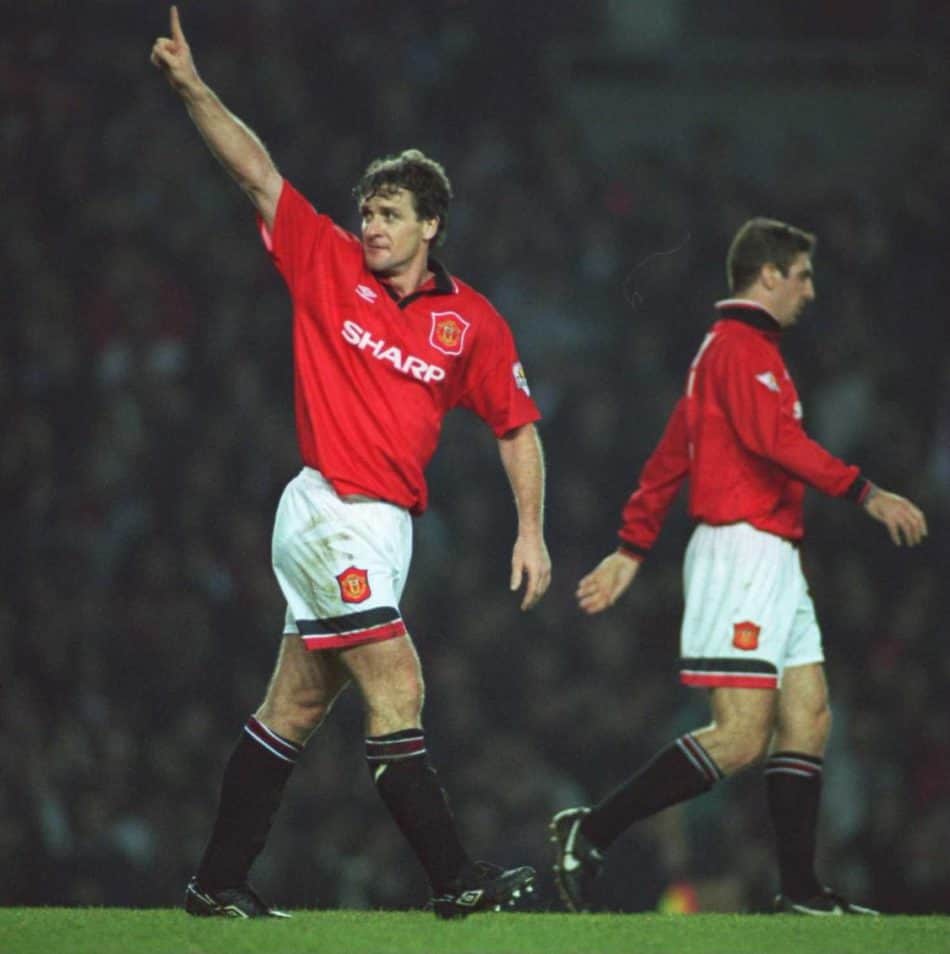
An injury resulting from a collision with Newcastle goalkeeper Pavel Srnicek also threatened to put him out of commission earlier in the season, but this was fortunately ruled to be just a gash. He saw action again just a month later.
A long suspension for Eric Cantona for attacking a fan briefly gave safety to Mark Hughes in the line-up, and he had a short partnership with new star Andy Cole. They came close to winning the Premier League and FA Cup in that season but failing to beat West Ham United in the final league game and losing to Everton in the FA Cup Final meant United were trophy-less for the first time in 6 years. That fateful FA Cup Final would prove to be Mark’s last game for the Red Devils.
Asked if he was surprised to be let go by Sir Alex Ferguson, he replied that he wasn’t at all because he’d already been replaced when the club bought Andrew Cole. Furthermore, he commented on the matter: “I’d had a long time being the first-choice striker and a big part of my life had been spent at United. I went there when I was 14 and left when I was 31 so I can’t complain. I knew it was right for me to leave and it was right for the club.”
So, on June 1995, Manchester United bade farewell to Mark Hughes with a transfer to Chelsea FC for £1 million. He had served his club well with over 467 appearances spanning his two stints at United, contributing 163 goals in total, with 116 of those goals coming after his return from Barcelona.
Mark Hughes – The Rest of His Playing Years
His time at Chelsea was one of the better spells of his career, apart from Manchester United. In fact, he used to support The Blues while growing up. In his second season he would form a new strike partnership with Gianfranco Zola and Gianluca Vialli, and he played a crucial role in bringing the club back to glory in the late ’90s. He racked up several major achievements playing at Stamford Bridge, including winning the 1997 FA Cup and the 1998 UEFA Cup Winners’ Cup. He was the only player in the 20th century to have won the FA Cup four times.
After three seasons playing at Stamford Bridge, he transferred to Southampton on July 1988. It proved to an unsuccessful move for Hughes, as his performances simply weren’t on a level with the brilliance he showed with United and Chelsea. He was moved back into the midfield, where he fared a little better. He also set a new record, albeit in a negative way, by receiving a total of 14 yellow cards in his first season at Southampton, a record which still holds today. Nevertheless, his experience helped Southampton maintain their place in the top tier of English football.
Mark had a brief stint at Everton after disagreements with new Southampton manager Glenn Hoddle in March 2000. He stayed for just seven months at Goodison Park, playing 16 games and scoring only 1 goal.
He left shortly afterwards to join Blackburn Rovers, the first team he ever played in that was outside the top English league. He helped them achieve promotion to the Premier League in 2001 and win League Cup in 2002. He scored what would be his final career goal in April 2002, in a 3-1 defeat against Leicester City.
On July 2002, a few days before turning 39, Mark Hughes brought an end to his brilliant playing career. He closed this chapter of his life with an incredible 224 goals in 799 league appearances and 16 goals in 72 caps with the Welsh national team.
Mark Hughes – From Player to Manager
Even before he hung up his boots for good, Hughes was beginning to move into management, and he always knew that this was something he would do after retiring from the pitch. His first managerial gig was actually overseeing his country’s national team in 1999. Initially brought in as a temporary replacement for then Welsh manager Bobby Gould, he managed to earn himself the job and stayed on until 2004. During his time, Wales almost qualified for UEFA Euro 2004, ending up second in their group but unfortunately losing to Russia in a play-off to miss out on the finals.
His next managerial job saw him saving his last club, Blackburn, from falling into relegation. He built a competitive lineup for the club, including such signings as Benni McCarthy, Roque Santa Cruz, Christopher Samba and David Bentley. This proved to be a significant improvement, as Rovers saw themselves finish in the top 6 in the league and therefore qualify for the UEFA Cup. His next two seasons saw Rovers finish tenth and seventh respectively, but finish bottom of the league’s disciplinary table, with a slew of accusations of dirty play. He won the Premier League Manager of the Month award on October 2007, his last season at Ewood Park.
On June 2008, Mark Hughes went on to manage Manchester City, having been the first choice to replace sacked manager Sven-Goran Eriksson. During his tenure, he recruited top players from around the world, including Israeli player Tal Ben Haim and Belgian defender Vincent Kompany, who would go on to captain the club. His time at Manchester City would get off to a good start with wins over former clubs Barcelona and Blackburn. They began the season with five clean sheets, but a string of draws caused their campaign to peter out disappointingly. He was sacked on December 19, 2009.
In 2010, he started a new stint managing Fulham, replacing Roy Hodgson, and led the club to an 8th place finish. But Hughes would go on to resign from the club to “further his experiences”, a move that drew flak from Fulham and one he would regret years after. It was followed by an equally short time managing Queens Park Rangers, a role from which he was dismissed in November 2012
His longest spell of club management thus far came with Stoke City, a club he would go on to lead for 5 years. His first season with them started off very poorly but recovered in the latter stages after he swapped big striker Kenwynne Jones for the more mobile Peter Odemwingie, enabling him to adopt different tactics. This saw them end in 9th place, their best finish since the 1974/75 season. Hughes’s tactics continued to produce sound results, as Stoke also went on to finish in 9th place for the next two seasons. By the 2017/18 season, however, they were under threat of relegation, winning only 5 of their first 22 games. After a 2-1 FA Cup defeat to League 2 Coventry City, Mark Hughes was sacked on January 2018.
His last club managerial role to date, at Southampton, saw a similar end. Hughes was sacked in December 2018 with the team languishing in 18th place.
Mark Hughes – Playing Style
Possibly one of the most brilliant strikers to ever grace Old Trafford, Mark Hughes was a prolific goalscorer who probably created as many goals as he scored. Sir Alex Ferguson once mentioned that Mark was one of the best players he had ever known, and for good reason. He combined the deft touch and grace of a ballerina, the acrobatics of a gymnast and the extreme power of a sledgehammer, thanks to his thick tree-trunk like legs. Nowhere is this better illustrated than in his mid-air scissor kick goal against Spain.
So effective was his style that it was once rumored that a Liverpool player was overheard saying: “We’ll be OK as long as they don’t bring Hughes in”. Liverpool were leading that game 2-0, and Hughes was a sub at the time. That player’s fear turned out to be valid, as Hughes quickly scored once he entered the pitch, and helped to stage an amazing comeback.
He fought hard for the ball, and knew how to create opportunities for his teammates, leading to fruitful partnerships with some of the best players in the game, such as Eric Cantona and Gianfranco Zola.
Mark Hughes – The Man Off the Field
On the pitch, Mark Hughes was known as an aggressive, player, with more yellow and red cards awarded to him than he cares to count. Off the field, however, he is a totally different person – quiet and acutely shy with a gentle demeanor. One would be hard-pressed to connect the two Marks!
He credited his transformation on the pitch on an inner frustration because he felt he wasn’t showing how good he was during his early years at United. “So I started lashing out a bit. And when I started getting aggressive, I started making progress. So I stuck with it.” Mark recalled.
For all his life, Mark Hughes has been fiercely loyal to his hometown, Ruabon. During his early playing years, he would often return to Ruabon from Manchester after matches. Despite his successes in the following years, he has not forgotten his roots and still maintains friends in his hometown, where he is a local legend.
An amateur journalist once phoned Mark Hughes in Southampton asking for an interview for his portfolio, and when Mark found out that the journalist was from Ruabon, he agreed. Despite the fact that on that day he was swamped by the media (due to it being the day Mark was appointed as manager of the Wales national team), he was true to his word and gave the only interview to the Ruabon native. He even gave the same man a lift to the train station when he passed him at a bus stop later on.
In April 2003, he also interrupted his busy schedule as Wales manager to inaugurate the new sports facilities in his home town.
In 2004, Mark Hughes was awarded the OBE, in recognition of his services in turning around the Wales national team and leading the team on a 10 game unbeaten run from 2001-2003.
Hughes is a proud family man. He and wife Jill have three children, sons Alex and Curtis, and international hockey-playing daughter Xenna.
Mark Hughes Playing Career
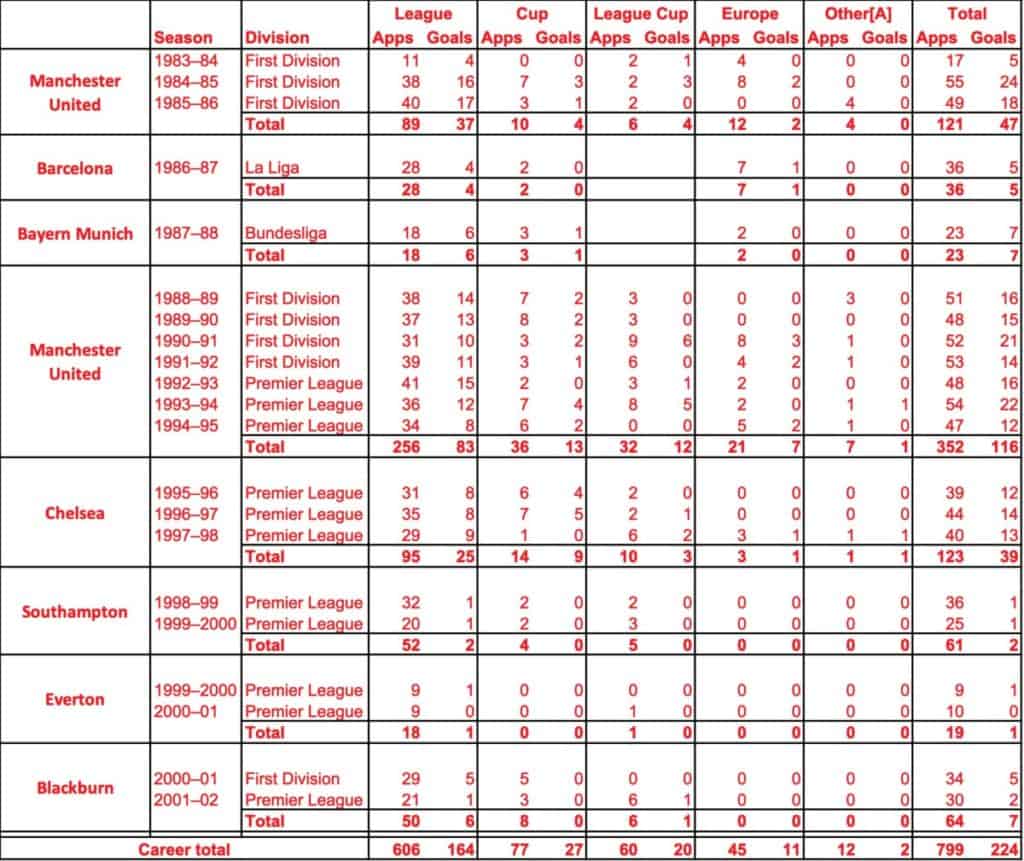
Managerial Record

Wales Record
